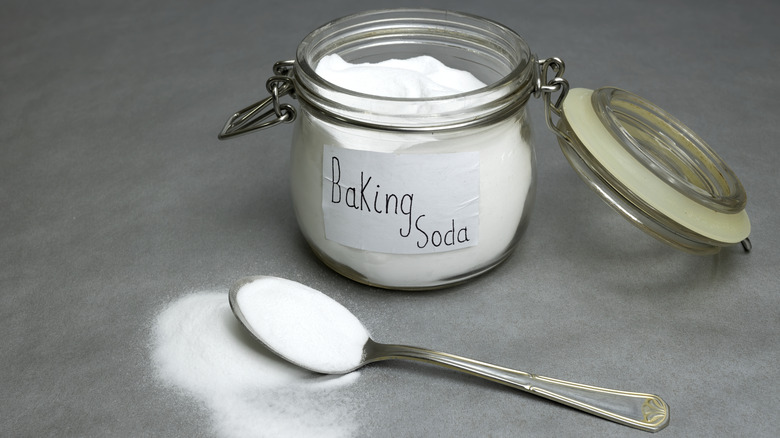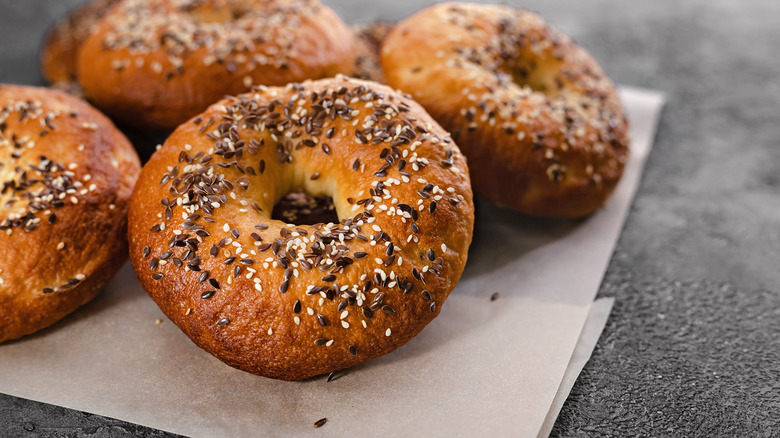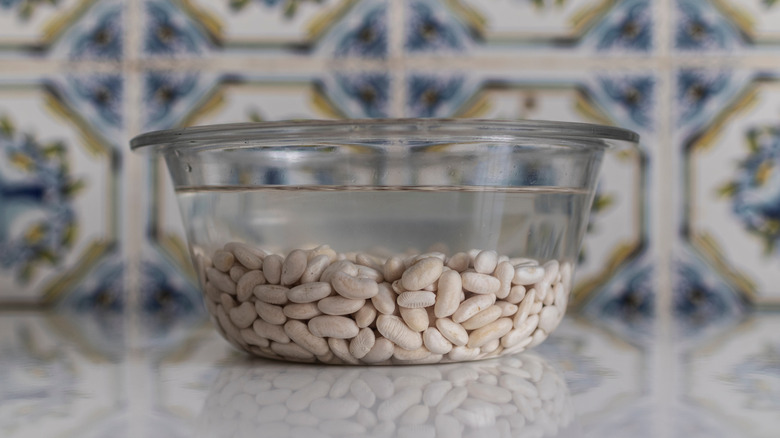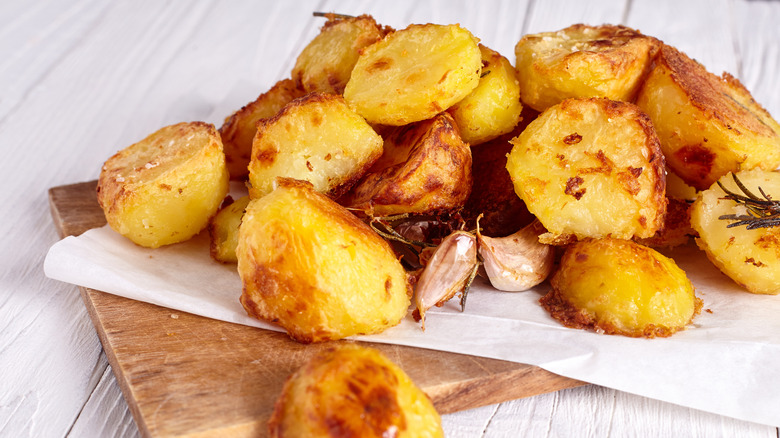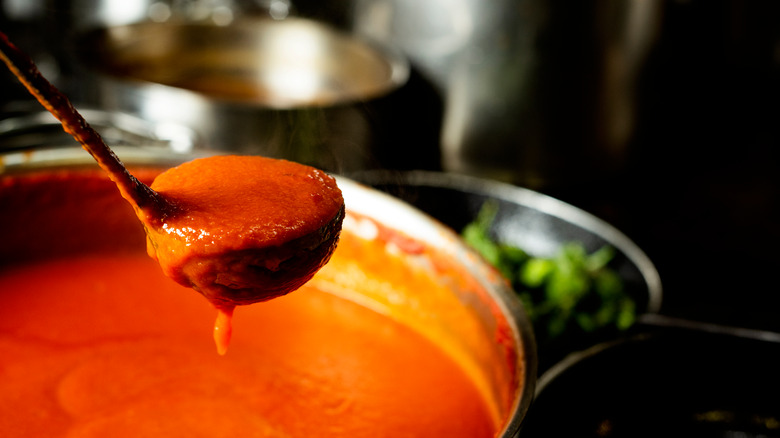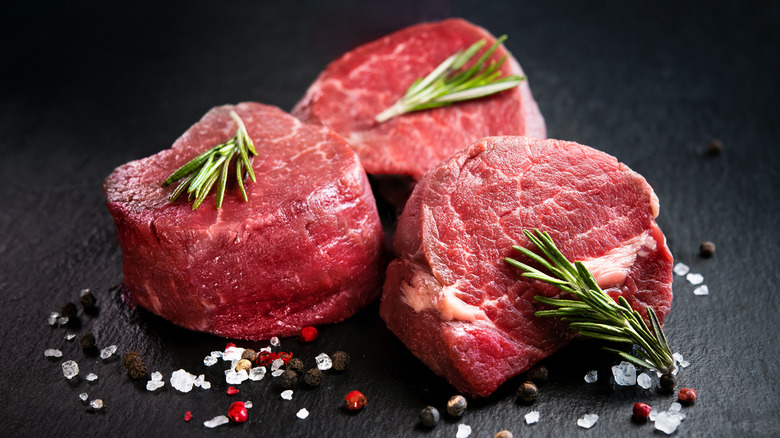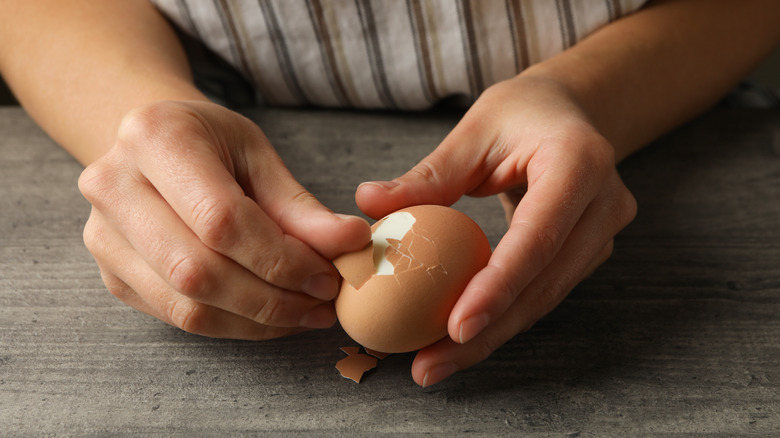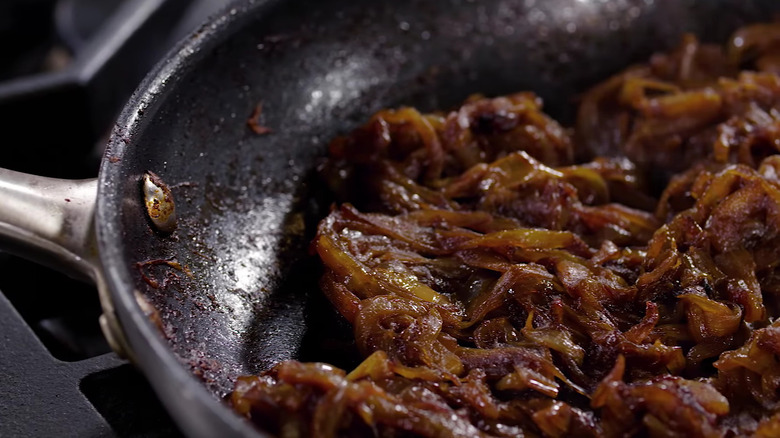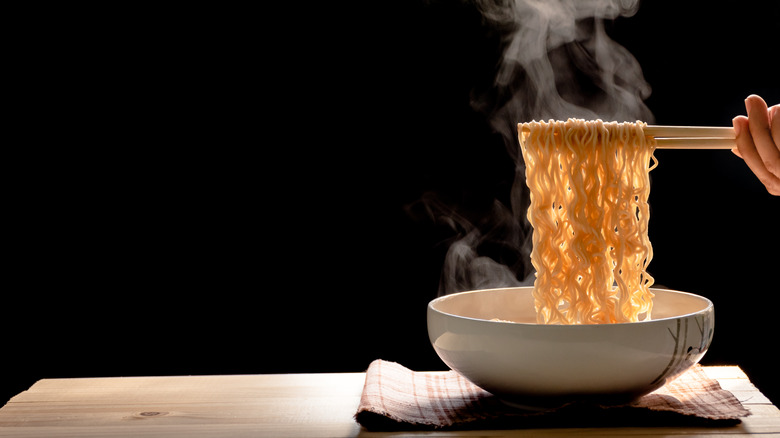8 Unexpected Ways To Cook With Baking Soda
Baking soda, also known as sodium bicarbonate, is a pantry staple that nearly all cooks will associate with one thing — baking. That's because baking soda has been widely used as a leavening agent since first being produced in the United States in 1846, per Smithsonian Magazine.
However, naturally occurring forms of baking soda, such as natron, have been used for various tasks by human civilizations for millennia. In Ancient Egypt, natron was used for the creation of glass, as a medicine, and in the mummification process, as reported in Revue d'histoire de la pharmacie. Baking soda is still employed for a variety of uses, including both cleaning and deodorizing.
Given its history as an extremely multifaceted item, it's somewhat surprising that baking soda has been employed in such a singular role in most kitchens, especially because baking soda can transform many cooking processes, resulting in shorter frying times, improved textures, and far more balanced sauces. Indeed, baking soda is quite versatile, yet it has been criminally underused within the culinary setting. In an attempt to right this wrong, we have collated a list of lesser-known ways to employ baking soda within your kitchen in order to improve your dishes and get this leavening agent the gastronomic respect it deserves.
1. Help to brown bagels
Home bakers have long lamented the lack of a rich, chewy, and dark golden-brown crust on their pretzels and bagels. However, comparing home-baked goods with those from a bakery is not entirely fair. This is because professional bakers and producers achieve this trademark color and texture through the use of lye, a hazardous, toxic, and extremely alkaline product, as reported by The New York Times.
The Journal of Agricultural and Food Chemistry highlights that alkaline conditions — lye has a pH level somewhere between 13 and 14 — speed up the Maillard reaction, the complex process wherein proteins and sugars are altered by heat, resulting in flavors, smells, and other phenomena such as browning. The reason alkaline environments or products such as lye speed up this reaction is because they allow amino acids and sugars to interact on a more frequent basis, as reported by The Star.
Baking soda has a pH of eight, which, although much lower than lye, still makes it alkaline. As such, boiling bagels in water mixed with baking soda helps speed up the Maillard reaction and achieve a well-browned bagel. This process can be somewhat enhanced by following the advice of cooking-science pioneer Harold McGee, who recommends roasting the baking soda in the oven first. This will concentrate its properties and take its pH closer to lye, although it will become slightly more hazardous as a result (via The New York Times).
2. Aid bean cooking and digestion
An experiment performed by Cook's Illustrated highlighted how the pH of a cooking liquid can affect the cooking time of beans and legumes. Simply adding 1% of baking soda — by weight — to 5 cups of water made the cooking time for black beans dramatically fall when compared to the time it took to soften beans cooked in neutral (pH7) or acidic water.
The bean's cooking time is significantly reduced due to a simple scientific interaction. As Dr. Guy Crosby, science editor of America's Test Kitchen, explains, "an alkaline environment causes the pectin molecules to break down into smaller molecules that greatly weakens the pectin causing the beans to soften much more rapidly. Beans cooked with a tiny amount of baking soda added to the cooking water cook in about half the time as beans cooked without" (via The Bean Institute).
Even soaking beans in alkaline water has its benefits as the pH helps break down oligosaccharides, sugars that humans cannot easily digest. This results in a reduction of bloating and flatulence that many experience when first adopting a diet heavy on beans and legumes (via Health Digest).
3. Make roasted potatoes crispier
The ability of baking soda to weaken and break down pectin — structural molecules found in the cell walls of plants — can be employed to benefit a wide range of dishes and ingredients. As highlighted by J. Kenji López-Alt in The New York Times, adding baking soda during the parboiling stage of roasting potatoes will ensure that the potatoes have an extremely crisp crust upon exiting the oven.
This is because baking soda, as an alkaline product, raises the water's pH level. The alkaline pH levels then cause the pectin in plant cell walls to break down — in this instance on the potato's surface (per Food Chemistry: X). As the pectin breaks down, the surface of the potato becomes softer, adopting a fluffy and more textured appearance. Upon dousing with boiling fat and tossing roughly, this softened surface becomes covered in a thick potato and fat slurry. This slurry will transform during the roasting period, eventually forming a beautiful, crisp, golden crust.
4. Balance acidity in sauces
Classic gastronomic training suggests there are two main ways to balance out an overly acidic sauce: through the addition of sugar or the addition of fat (per Food & Wine). However, adding these components — while minimizing the effect of acids — also changes the flavor and texture of your entire dish.
Alternatively, baking soda can be used to counteract acidity without affecting the sauce in any other way. If used correctly, baking soda will not impart flavor as sugar does, nor will it affect texture or taste in the myriad of ways fat does. Rather, the baking soda will quite simply raise the pH of an acidic sauce closer to seven, the point of neutrality.
Of course, this process is not entirely without its risks. The addition of too much baking soda can result in the creation of an extremely unpleasant bitter aftertaste that will ruin your final dish, as highlighted by Southern Living. As such, it is vital to add baking soda to your sauce slowly and always taste as you go.
5. Tenderize meat
By now, baking soda's ability to soften vegetables has been well elucidated. However, baking soda's tenderizing abilities are not limited to vegetables alone; the crafty pantry staple can also be used to tenderize the toughest of meats.
As explained by Livestrong, soaking meat in a solution of water and baking soda will alter the surface of the meat by making it alkaline. However, instead of breaking structural molecules down — as a high pH does to plant matter — the meat is softened due to the alkaline environment denaturing proteins on its surface. Ultimately, this prevents the proteins from bonding to one another when exposed to heat, meaning the meat does not close up and toughen. This ensures that the meat remains tender throughout the cooking process.
The process of tenderizing meat through the use of an alkaline solution is best suited to smaller cuts of meat, such as strips of steak. This is because smaller cuts have a larger surface area to volume ratio, ensuring a greater proportion of the meat's protein becomes denatured. This will result in the whole cut feeling tender. However, The Washington Post reports that large pieces of meat can be tenderized by applying baking soda directly onto the meat, much like a spice rub. The meat should consequently be left to rest before cooking. This method is also an effective way of transforming cheaper cuts of meat, such as shanks, from tough to tender.
6. Peel boiled eggs easier
Accidentally ripping hunks from your egg as you attempt to peel it is perhaps one of the most frustrating moments many home cooks face. Slate reports that the eggs that tend to be difficult to peel are freshly laid ones. This is because freshly laid egg whites — known as the albumen — contain carbon dioxide, meaning the albumen is slightly acidic. While not a problem in and of itself, the acidic nature of a freshly laid albumen causes it to bind tightly with the keratin present in the egg's inner membrane. It is this tight bond that causes chunks of cooked albumen to be ripped off as you peel your egg.
While carbon dioxide leaks through the shell as the egg ages — thus explaining why older eggs are easier to peel — the pH of the albumen can be artificially raised by boiling the egg in a baking soda and water solution (via Daily Mail). This ensures that the white does not bond as firmly with the keratin present in the inner membrane of the shell, hypothetically resulting in a boiled egg that is much easier to peel.
7. Speed up the Maillard reaction
Illinois Science Council highlights that the Maillard reaction is the process behind many of the tastes, textures, and aromas that we humans find so appealing. As previously mentioned, the inclusion of baking soda can help cooks manipulate this reaction by speeding it up — a phenomenon that results from amino acids and sugars interacting more regularly (via The Star).
The ability to speed up the Maillard reaction is not unique to baking soda; most cooks are aware that increasing heat can do much of the same. However, dramatically increasing cooking temperatures creates the risk of food becoming burnt in a process known as pyrolysis which, according to Modernist Cuisine, occurs at temperatures above 355 degrees F.
By including baking soda, cooks can speed up the Maillard reaction without exposing their food to temperatures that may cause burning, allowing them to save time without running the risk of potentially ruining their dish. For example, adding baking soda to a frying pan full of sliced onions can dramatically reduce the notoriously long time it takes to caramelize them, with The National Onion Association reporting that cooking times were reduced by over 30 minutes when baking soda was added. However, The National Onion Association also notes that the inclusion of baking soda can cause the already fragile onions to break down completely, resulting in an overly soft texture not suited to all dishes.
8. Transform pasta into noodles
As reported in Asian Noodle Manufacturing, the two key characteristics of ramen noodles are a wheat-based dough and the presence of kansui, a type of alkaline water that is incorporated into the dough. The latter influences the noodles significantly, with a study published in The Journal of Cereal Science demonstrating that alkaline salts and solutions can alter the noodle's cooking time, hardness, adhesiveness, and chewiness, as well as change the abundance of various proteins. In fact, alkaline solutions influence wheat-based doughs so significantly that other wheat products, such as pasta, can be transformed into a passable noodle stand-in simply by being cooked in an alkaline solution.
As we have seen, an alkaline solution can be simply made by adding baking soda to water, meaning this cupboard stalwart can almost single-handedly produce noodles from pasta. However, the cooked pasta must be washed thoroughly to prevent baking soda's metallic and bitter aftertaste from tainting your finished dish, per Piece of Oishi.
